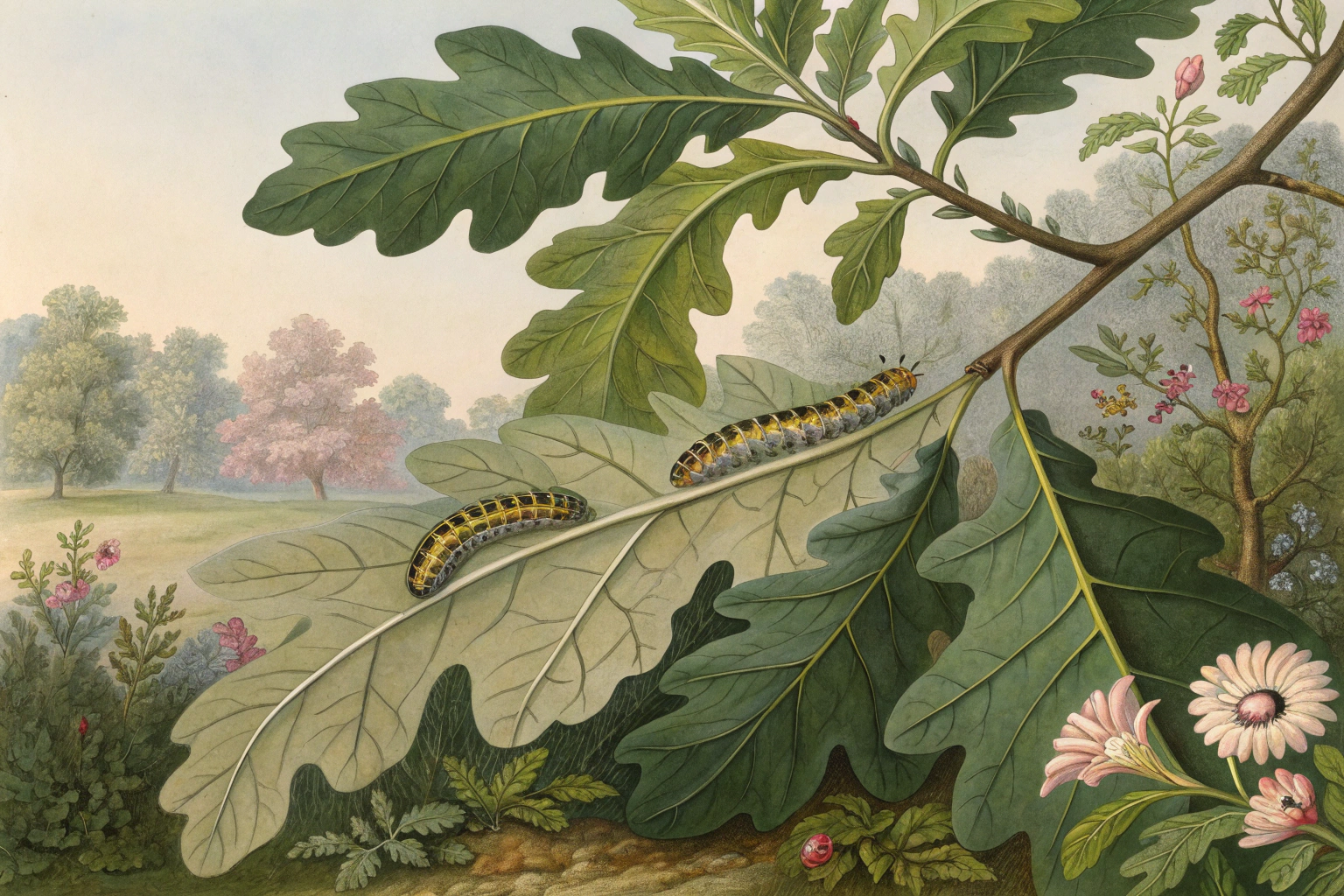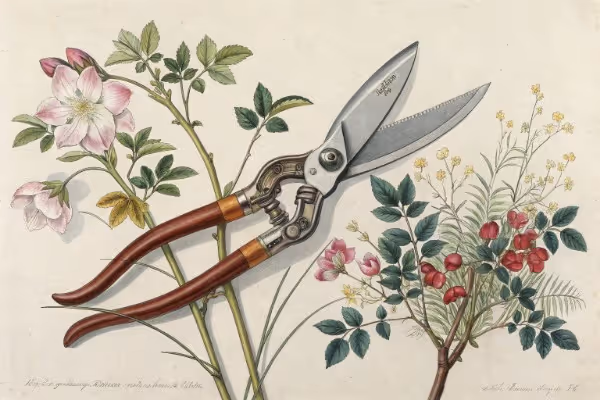Leaf Rollers: Identify, Control, and Prevent Garden Damage

leaf rollers
Leaf rollers twist and fasten leaves with silk to shape hiding spots, chew damage, and stress plants. Spotting leaf rollers early stops larger infestations before they take off. Handpick rolled leaves and check for telltale webbing—catching leaf rollers before they can multiply saves entire branches.
Discover which species lurk in your region, learn why your favorite plants attract them, and pick up proven ways to fight back, organically and otherwise.
Cheatsheet: Outsmarting Leaf-Rolling Pests Fast
🪲 Signs
- Leaves folded or stuck together
- Webbing visible on leaf edges
- Chewed foliage and dropping leaves
- Small green or brown larvae inside rolled leaves
🌱 Vulnerable Crops
- Roses, apples, citrus, grapes, berries
- Many edibles and ornamentals
- 80+ plant varieties targeted globally
🧰 Tools and Products You'll Need
- Pruning shears
- Neem oil or Bacillus thuringiensis (Bt)
- Sticky traps
- Gloves
- Bucket of soapy water
🔪 Manual Removal
- Inspect plants daily for rolled leaves
- Snip infested leaves with shears
- Drop leaves in soapy water bucket
🦠 Organic Sprays
- Mix 2 tsp neem oil or Bt per quart (1L) water
- Spray early morning on affected plants (below 85°F / 29°C)
- Repeat after rain or every 7 days until clear
🐦 Beneficial Allies
- Attract parasitic wasps and birds to eat larvae
- Plant dill, fennel, or alyssum to draw helpers
💪 Prevention
- Remove weeds and garden debris
- Check new plants before adding to garden
- Keep plants healthy to resist attacks
- Rotate crops every season
🌿 Health + Self-Sufficiency
- Less leaf loss means more yield per harvest
- Boosts plant resilience and organic food supply
- No toxic chemicals needed for control
Leaf Rollers: The Caterpillar Architects of the Garden
What Exactly are Leaf Rollers?
Leaf rollers are the larval form of several moth species in the Tortricidae family. These small caterpillars expertly fold and fasten plant leaves together with silk, creating a shelter and a snack in one move.
I’ve watched a tiny Archips argyrospila at work on a peach tree, rolling the leaf edge with precision that would impress an origami artist. Inside, the caterpillar munches away, hidden from predators and, often, from unsuspecting gardeners.
Common Signs of Leaf Roller Activity
- Leaves folded, rolled, or tied together with fine silk threads
- Brown, dead patches or skeletonized leaves inside these rolls
- Frass (a polite garden term for caterpillar droppings) within or below the roll
According to the University of California IPM program, “Extensive leaf rolling can reduce plant vigor, especially in young or stressed fruit trees.” I’ve seen grapevines lose half their leaf surface to leaf rollers in a matter of weeks during a particularly warm spring.
Host Plants: A Varied Palate
These insects don’t discriminate. They target fruit trees—apples, pears, plums—roses, maples, oaks, and even berry brambles.
I once found my prize 'Burgundy Belle' maple festooned with little green tents, each sheltering a wriggling inhabitant. Grapevines and blueberries often take a beating, too.
Life Cycle and Timing
Leaf rollers overwinter as eggs or pupae, depending on the species. Come spring, larvae emerge just as tender new leaves unfurl.
Here in USDA zone 7 (I garden just outside Asheville), the first instars show up when temperatures hit 55°F (13°C) for several days in a row. Adults appear later in the season, laying eggs for a second, sometimes even a third, generation if the weather obliges.
Why Control Leaf Rollers?
Minor infestations barely slow down healthy plants. Still, a heavy outbreak can decimate foliage and reduce fruit yields.
“Severe fruit injury may result if larvae feed on young fruitlets,” warns Dr. Emily Gude at the Michigan State University Extension.
If you’re growing apples for local markets, even a few damaged fruit can lead to significant losses. Appearance sells.
Best Ways to Control Leaf Rollers
Integrated Pest Management (IPM) Strategies
- Prune and Destroy: Remove and trash infested leaves as soon as you spot them. Don’t compost them unless your pile runs hot (over 140°F/60°C). I patrol my orchard every week from late March through June, shears in hand.
- Natural Predators: Birds, spiders, parasitic wasps (like Trichogramma) love leaf roller larvae. Attract these allies with diverse plantings and avoid broad-spectrum insecticides that wipe out beneficial insects.
- Bacillus thuringiensis (Bt): This biological pesticide, derived from a soil bacterium, targets caterpillars but spares bees and ladybugs. For best results, spray when eggs hatch and larvae are young (first or second instar). Too late and they’re snug in their leafy bunkers—anecdotal proof: I missed a week last spring and paid the price in shredded plum leaves.
- Horticultural Oil: Oils applied during winter dormancy suffocate overwintering eggs on fruit trees. I use a light paraffinic oil at 2% solution in mid-February, timing it just before bud break.
Chemical Controls
Insecticides work, but timing matters. Contact sprays rarely reach larvae once leaves are rolled. Systemic products, like spinosad, can be useful but may harm pollinators if misapplied. Always consult your county extension office for recommendations that fit your crop, climate, and local regulations.
Listicle: Top 4 Alternatives to Synthetic Sprays for Leaf Roller Control
- Bacillus thuringiensis (Bt) – Targets caterpillars, leaves beneficials unharmed. Apply just as larvae hatch.
- Regular Pruning – Hand remove rolled leaves weekly during active periods.
- Sticky Traps – Monitor adult moths to time your interventions. Cheap, effective, and surprisingly satisfying.
- Encourage Birds – Install birdhouses and keep feeders stocked in early spring. Chickadees and wrens love to hunt for caterpillars.
Commercial Products and Where to Find Them
Look for Bt sprays under brands like Monterey or Safer. Horticultural oils appear at every decent nursery. Sticky traps are available online and at local garden centers. My favorite scouting trick: a simple roll of yellow tape, sticky side out, looped around a branch catches adults before eggs are laid.
Personal Experience and Pro Tips
Early intervention always saves the season. Waiting until you see rolled leaves on every branch means playing catch-up. I’ve also found that rotating biological and mechanical controls keeps populations in check without harming pollinators.
“Patience and persistence beat panic every time,” quipped my old mentor, Vera, whose apple harvests won blue ribbons for decades.
If you want step-by-step guidance tailored to your microclimate and plant choices, you can get personalized gardening instructions from Taim.io.
Interesting Statistics
- Over 1,000 Tortricid moth species in North America roll leaves as larvae (Entomological Society of America).
- Leaf roller outbreaks can reduce fruit yields by up to 30% in untreated orchards (University of Florida Extension).
- Studies show Bt reduces leaf roller populations by more than 75% when applied at first hatch (Journal of Economic Entomology).
Final Thoughts
Leaf rollers have turned leaf folding into high art. With vigilance, a few sharp pruners, and a little biological backup, any gardener can keep these tiny architects in check. Some seasons they’ll test your patience, but the rewards—a flush of healthy, unblemished leaves and fruit—are well worth it.

Want smarter plant choices? 🪴
Frequently Asked Questions About Leaf Rollers
How can I tell if these caterpillars have infested my plants?
Look for rolled or folded leaves held together with silk webbing. Inside, you may spot small caterpillars feeding on the foliage. Leaves may show chewed edges, brown patches, or holes. In flowering plants and fruit trees, damaged buds or fruit scars can also signal their presence.
Which plants face the highest risk?
Fruit trees such as apple, citrus, and plum attract them most often, but ornamental shrubs, roses, and some vegetables may also draw these pests. Plants with thin, delicate leaves or soft new growth prove especially vulnerable in late spring and early summer.
What causes an outbreak to escalate?
Warm, humid weather (above 75°F/24°C and 60% humidity) can encourage rapid population growth. Over-fertilization with nitrogen promotes lush foliage, creating ideal breeding grounds. Lack of natural predators, like birds or parasitic wasps, can also trigger heavier damage.
How do I control these pests without chemicals?
Handpick and remove rolled leaves, or prune heavily infested shoots. Encourage beneficial insects like lacewings, trichogramma wasps, and certain birds. A strong blast of water can knock larvae to the ground. Apply Bacillus thuringiensis (Bt), a biological control, during early larval stages for greatest effectiveness.
Should I worry about long-term plant health?
Occasional infestations rarely kill plants, but repeated attacks can stress trees and shrubs, reduce yields, and invite secondary infections. Monitor regularly during the growing season and remove affected foliage promptly to help plants recover and maintain vigor.
Leaf rollers don’t ask for permission. They show up, roll up, and get to work on your prized leaves. Spotting their handiwork early gives you the upper hand—look for webbing and folded leaves before they take over. Squash the rolled leaves if you catch them, or bring in natural predators like birds and parasitic wasps. If you’re growing vegetables or rare houseplants, regular checks are non-negotiable. Go easy on the chemicals; you want pollinators, not collateral damage. A little vigilance and some handpicking go a long way. For more on resilient edibles and smart pest management, visit the Taim blog. With leaf rollers, sharp eyes and steady hands win every time.
Pro Tips: Outsmarting Leaf Rollers with Precision
Leaf roller caterpillars destroy leaves from within their silken shelters, decimating up to 30% of fruit tree foliage in a single outbreak. Their damage weakens growth and slashes yields, forcing growers to rethink their approach. Early, targeted intervention transforms the odds from loss to renewal.
Microclimate Adjustments
- Boost airflow by thinning crowded branches; leaf rollers struggle on dry, breezy foliage.
- Water in early morning: moist overnight conditions favor larvae. Soil drying by noon discourages activity.
Nutrient Timing
- Apply potassium-rich feeds (e.g. wood ash, kelp meal) in late winter; potassium-fortified tissue resists chewing.
- Avoid heavy nitrogen after early spring. Weak, fast growth entices moths.
Repelling and Attracting Insects
- Interplant with calendula, dill, or sweet alyssum to attract predatory wasps and lacewings—both devour larvae.
- Spritz leaves with a strong tea from crushed tomatillo or tomato foliage—the alkaloids repel egg-laying moths.
Ultra-Early Monitoring
- Inspect folded leaf edges at daily intervals March–June (USDA zones 5–8), or as soon as temps hit 50°F/10°C.
- Unfurl and crush caterpillars on sight to break the breeding cycle before populations spike.
Zero-Residue Cleanup
- Bag and remove prunings—larvae overwinter inside shelters on clipped twigs.
- Clear plant waste from orchard floors: pupae persist in fallen debris until spring warmth reactivates them.
Self-Sufficiency Benefit
Reducing leaf roller loads by 80% restores tree vigor, increases fruit minerals, and retains B-complex vitamins that defoliation can deplete.
Find out which plants will thrive in your garden!
Answer a few fun questions and get custom plant recommendations perfect for your space. Let’s grow something amazing together!

start your season





